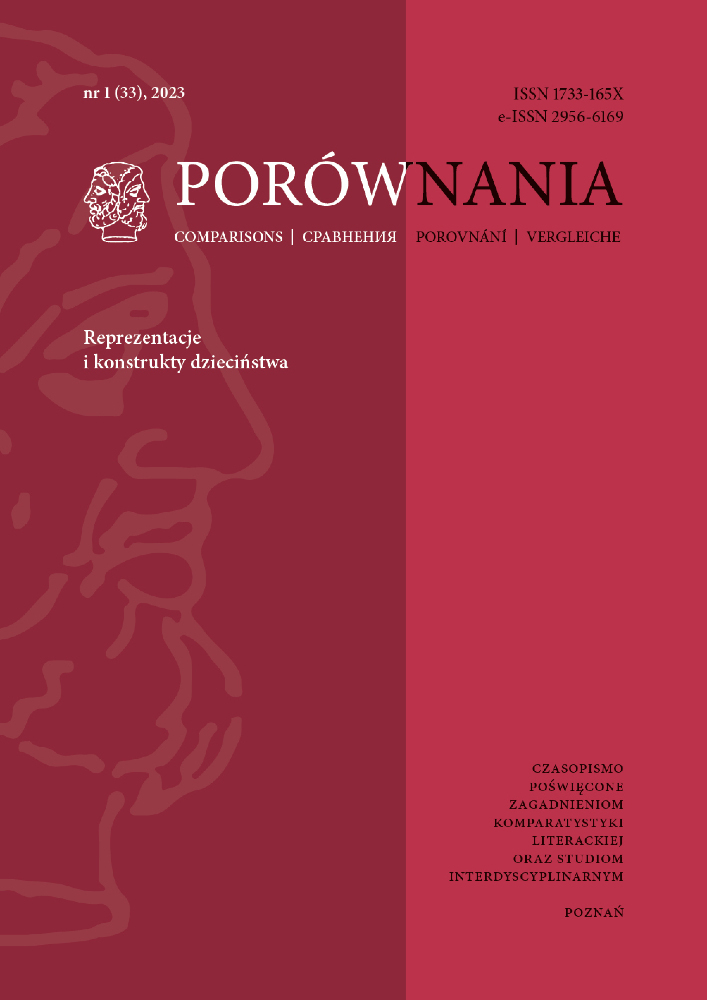Abstract
The article is an attempt at a cross-sectional view of the principles of constructing a child hero in the literature of Polish Romanticism, with reference to characters from selected popular literature of that period. The breakthrough that took place in the way of presenting the child, its experiences and emotions, and the evaluation of childhood by the creators of Romanticism inspires us to seek answers to the questions about what values were noticed in children, what made them unique, how their relationships with adults were shaped (including with parents), with peers and siblings, which was the specificity of their sensitivity and differences in the way they perceive the world (the role of imagination and dreams) and confrontation with the experiences of existence, often traumatic, leading to suicide. The discovery of the child as an autonomous being resulted in a revolutionary approach of artists of Romanticism, making the immature beings, alongside the mad, the people and the poets, revelators of the romantic world view, including epistemology based on an extra-rational way of getting to know the world and explaining its complex mechanisms.
References
Ariès Philip (1995), Historia dzieciństwa. Dziecko i rodzina w dawnych czasach, przeł. Maryna Ochab, Wydawnictwo Marabut, Gdańsk.
Goethe Johann Wolfgang (1984), Cierpienia młodego Wertera, przeł. Leopold Staff, PIW, Warszawa.
Hazard Paul (1963), Książki, dzieci i dorośli, przeł. Irena Słońska, Nasza Księgarnia, Warszawa.
Korotkich Krzysztof (2018), Czy romantycy nie lubili dzieci, „Bibliotekarz Podlaski”, nr 2 (XXXIX), s. 207–222. DOI: https://doi.org/10.36770/bp.117
Krasiński Zygmunt (1981), Nie-Boska komedia, oprac. Stefan Treugutt, PIW, Warszawa.
Kubale Anna (1984), Dziecko romantyczne: szkice o literaturze, Ossolineum, Wrocław.
Leszczyński Grzegorz (2006), Kulturowy obraz dziecka i dzieciństwa w literaturze II połowy XIX i XX wieku: wybrane problemy, Wydawnictwo Uniwersytetu Warszawskiego, Warszawa.
Mickiewicz Adam (1974), Wybór poezji, t. 1, oprac. Czesław Zgorzelski, Ossolineum, Wrocław.
Piwińska Marta (1974), Człowiek i bohater, w: Problemy polskiego romantyzmu, seria druga, red. Maria Żmigrodzka, Ossolineum, Wrocław.
Słowacki Juliusz (1987), Godzina myśli, w: tenże, Dzieła wybrane, oprac. oraz wstęp Julian Krzyżanowski, Ossolineum, Wrocław.
Zwolińska Barbara (2010), W poszukiwaniu tożsamości. O bohaterach powieści Narcyzy Żmichowskiej, Wydawnictwo Uniwersytetu Gdańskiego, Gdańsk.
Zwolińska Barbara (2017), Romantyczna historia łez. Prolegomena, „Literaturoznawstwo”, nr11, s.169–179. DOI: https://doi.org/10.25312/2451-1595.11/2017_21-34
License
Copyright (c) 2023 Barbara Zwolińska

This work is licensed under a Creative Commons Attribution-NoDerivatives 4.0 International License.
Utwory opublikowane w czasopiśmie „Porównania”, na platformie Pressto należącej do Uniwersytetu im. Adama Mickiewicza w Poznaniu są udostępniane na licencji Creative Commons Uznanie autorstwa - Bez utworów zależnych 4.0 Międzynarodowe (CC BY-ND 4.0)
Tym samym wszyscy zainteresowani są uprawnieni do korzystania z utworów opublikowanych pod następującymi warunkami:
-
uznania autorstwa — czyli obowiązek podania wraz z rozpowszechnianym utworem informacji o autorstwie, tytule, źródle (odnośniki do oryginalnego utworu, doi) oraz samej licencji
-
bez utworów zależnych — remiksując, przetwarzając lub tworząc na podstawie utworu, nie wolno rozpowszechniać zmodyfikowanych treści.
-
brak dodatkowych ograniczeń — nie można korzystać ze środków prawnych lub technologicznych, które ograniczają innych w korzystaniu z utworu na warunkach określonych w licencji.
Uniwersytet im. Adama Mickiewicza w Poznaniu zachowuje prawo do czasopisma jako całości (układ, forma graficzna, tytuł, projekt okładki, logo itp.).
Autor zachowuje prawa majątkowe, ale udziela zgody Uniwersytetowi im. Adama Mickiewicza w Poznaniu na wykorzystanie dzieła. Autorzy tekstów zakwalifikowanych do publikacji proszeni są o wypełnienie podpisanie i przesłanie umowa (PL) agreement (EN)
Agreement for granting a royalty-free license to works with a commitment to grant a CC sub-license





